Understanding and Managing Diarrhea in Large Animals
Abstract
Animal diseases in production and subsistence environments have the potential to negatively affect consumers, producers, and economies as a whole. A growing global demand for animal sourced food requires safe and efficient production systems. Understanding the burden of animal disease and the distribution of burden throughout a value chain informs policy that promotes safe consumption and efficient markets, as well as providing more effective pathways for investment. This paper surveys existing knowledge on the burden of animal disease across economic categories of production, prevention and treatment, animal welfare, and trade and regulation. Our scoping review covers a lot of papers across peer-reviewed journals and reports published by organizations. We find there exists a gap in knowledge in evaluating what the global burdens of animal diseases are and how these burdens are distributed in value chains. We also point to a need for creating an analytical framework based on established methods that guides future evaluation of animal disease burden, which will provide improved access to information on animal health impacts. An economic simulation was carried out over 183 milk-producing countries to estimate the global economic impacts of 12 dairy cattle diseases and health conditions: mastitis (subclinical and clinical), lameness, paratuberculosis (Johne’s disease), displaced abomasum, dystocia, metritis, milk fever, ovarian cysts, retained placenta, and ketosis (subclinical and clinical). Estimates of disease impacts on milk yield, fertility, and culling were collected from the literature, standardized, meta-analyzed using a variety of methods ranging from simple averaging to random-effects models, and adjusted for comorbidities to prevent overestimation. These comorbidity-adjusted disease impacts were then combined with a set of country-level estimates for lactational incidence or prevalence or both, herd characteristics, and price estimates within a series of Monte Carlo simulations that estimated and valued the economic losses due to these diseases. It was estimated that total annual global losses are US$65 billion (B). Subclinical ketosis, clinical mastitis, and subclinical mastitis were the costliest diseases modeled, resulting in mean annual global losses of approximately US$18B, US$13B, and US$9B, respectively. Estimated global annual losses due to clinical ketosis, displaced abomasum, dystocia, lameness, metritis, milk fever, ovarian cysts, paratuberculosis, and retained placenta were estimated to be US$0.2B, US$0.6B, US$0.6B, US$6B, US$5B, US$0.6B, US$4B, US$4B, and US$3B, respectively. Without adjustment for comorbidities, when statistical associations between diseases were disregarded, mean aggregate global losses would have been overestimated by 45%. Although annual losses were greatest in India (US$12B), the United States (US$8B), and China (US$5B), depending on the measure of losses used (losses as a percentage of gross domestic product, losses per capita, losses as a percentage of gross milk revenue), the relative economic burden of these dairy cattle diseases across countries varied markedly.
INTRODUCTION
- What is diarrhea in large animals?
- Why does quick treatment matter for herd health and farm profitability?
- Which therapies including rehydration, antimicrobials, and Diastop work best in different situations?
- How do I prevent diarrhea from reentering my herd?
Diarrhea is a commonly reported disease and a major cause of economic loss to cattle producers.The 2007 National Animal Health Monitoring System (NAHMS) for U.S. dairy reported that 57% of weaning calf mortality was due to diarrhea and most cases occurred in calves less than 1 month old. A similar mortality rate (53.4%) for dairy calves due to calf diarrhea was recently reported in Korea. The economic loss associated with calf death in Norway where calf production is 280,000 heads per year was estimated to be approximately 10 million US dollars in 2006. (nih) Livestock disease externalities negatively impact production and distort values due to domestic and international market shocks resulting in market inefficiencies. Herd health and sustainability of commercialized livestock product markets, as well as their growth to support demand, and smallholder farming systems are threatened by livestock disease outbreaks and occurrences in production. Livestock diseases can also encourage unsustainable and damaging practices. For example, antibiotics to promote growth may be used to increase animal size or address persistent infections, but the overuse of antibiotics may then contribute to adverse societal impacts, such as antimicrobial resistance. Establishing effective protocols that protect animal welfare and farm profitability needs an understanding of the complex relationships across environmental stressors, nutritional factors, and infectious agents that lead to diarrhea. (Frontiers)
What is diarrhea in large animals?
Diarrhea in large animals such as cattle, sheep, goats, and camels is most commonly associated with enterotoxigenic Escherichia coli, Cryptosporidium parvum, rotavirus, Coccidia, coronavirus, or some combination of these pathogens.
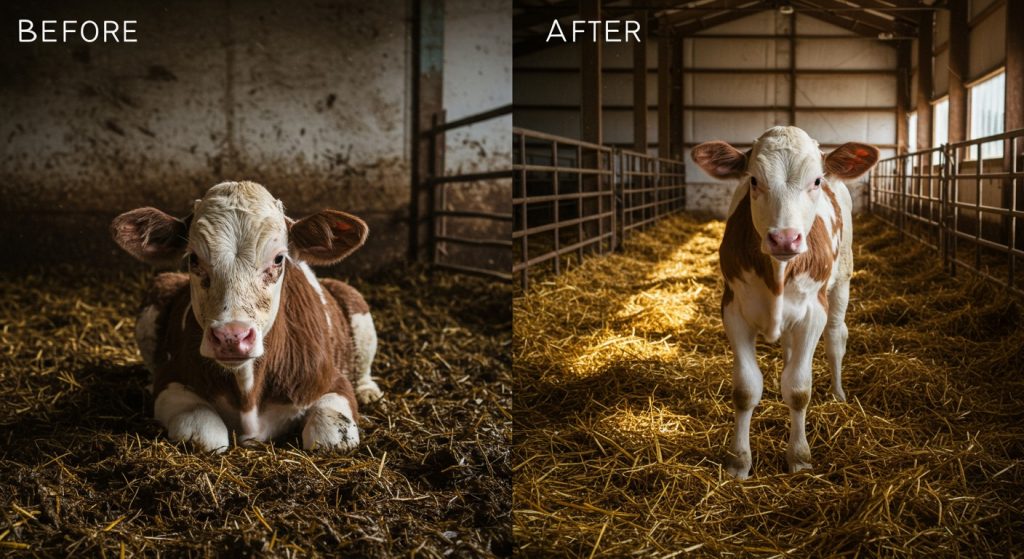
Each of these agents leads to diarrhea through either secretion or malabsorption/maldigestion, though the specific mechanisms and pathways may differ. Specific pharmacologic control and treatment are dependent on gaining a greater understanding of the pathophysiology of these organisms.
- Rotaviruses are the most common cause of neonatal diarrhoea in calves affecting 47% of diarrheic calves globally. Bovine rotavirus is a non-enveloped RNA virus that belongs to the family Reoviridae. The virus is present in most cattle herds and typically causes diarrhoea in calves between 5 to 14 days old. (The cattle)
- Cryptosporidium parvum, commonly referred to as Crypto, is a protozoan (a one-celled organism) that causes diarrhea in calves (as well as other mammals). This extracytoplasmic organism invades enterocytes (cells that line the intestines) in the distal small intestine and large intestine; therefore, intestinal pathology is worst in these portions of the intestines. (Cryptosporidiosis in Calves)
- Coccidia in cattle are in the genus Eimeria of which E bovis and E zuernii are the most common and pathogenic. This organism is one of the most common causes of diarrhea in calves from 3- to 6-months old, but infections can be seen in pasture beef calves or group housed calves as young as 3-weeks old. The prepatent period is 15 to 21 days. Eimeria can persist in the environment for years so exposure of calves after return from a calf ranch to the home dairy in the absence of a coccidiostat can precipitate the disease. Coccidiosis has not been seen in calf hutch calves.(nih) For more Information about What are anticoccidial drugs? check this link (Maizer)
Why does quick treatment matter for herd health and farm profitability?
Animal Diseases caused by bacteria, viruses, fungi etc. referred to as infectious disease are the most important disease of livestock and are the ones that most threaten increased livestock production in Nigeria. Animal Disease prevention or maintenance is an essential part of good livestock management practices. Animals are usually reared together in large numbers in one place. It is recognized that most important Livestock diseases spread easily and rapidly among animals that live close to each other. Disease prevention should take cognizance of this by preventing disease on a herd basis. The herdsman should always be alert to signs of sickness in the herd. This bulletin is intended to teach you how to keep watch on the health status of your herd. (naerls)
Animal diseases have multiple impacts, which have been highlighted from different perspectives. The impacts of endemic diseases are mainly felt at farm level, while broader economic impacts can occur with epidemic diseases that restrict trade in livestock and livestock products. The occurrence of such diseases impacts both poor and richer livestock producers by marginalizing them from higher-price livestock markets and restricting their capacity for value-added trade. The overall benefits of control of epidemic diseases are greater in rich countries; where resources are available for eradication, it is invariably carried out. Numerous recent examples, however, emphasize that maintenance of disease-free status when the disease occurs elsewhere is risky, for example FMD introductions worldwide and classical swine fever in the Netherlands. When considering pro-poor livestock development, it is necessary to highlight the impacts on the poor of epidemic diseases and their control, which include direct effects (highlighted below) and potential trade benefits. (fao)
Which therapies including rehydration, antimicrobials, and Diastop
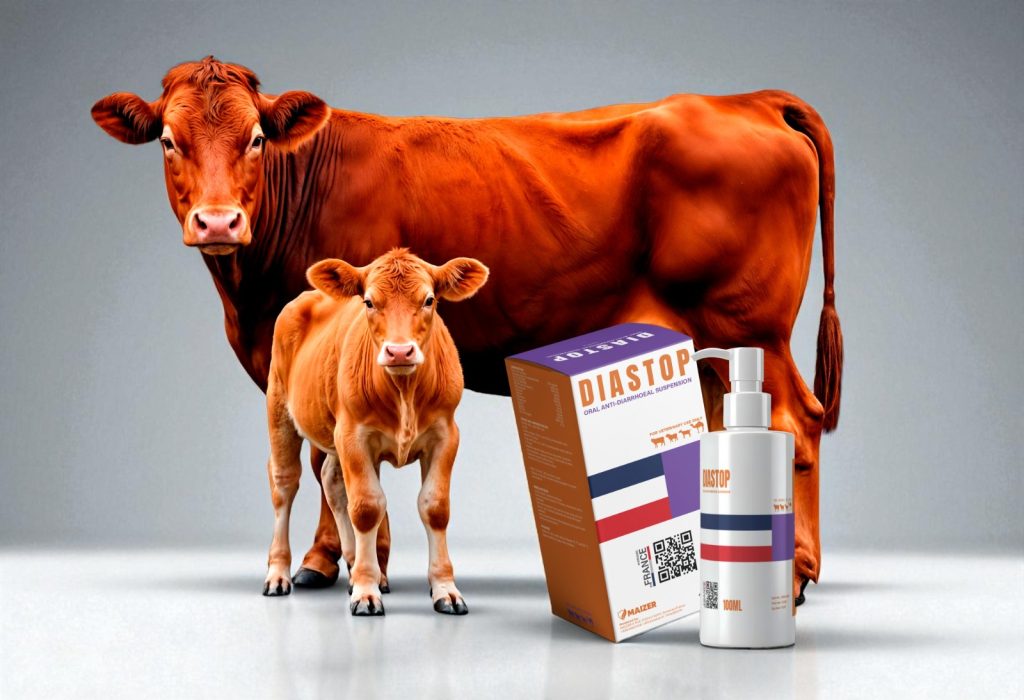
work best in different situations?
This review focuses on adjunct therapy of diarrhea in the first 3 weeks of life and therefore does not address the efficacy of adjunct treatment for calf diarrhea due to Eimeria bovis, Eimeria zurneii, or Giardia duodenalis. The main principles of ancillary treatment in neonatal calves with diarrhea and systemic illness are:
(1) treat or prevent Gram-negative septicemia and bacteremia.
(2) decrease the numbers of coliform bacteria in the proximal small intestine and abomasum.
(3) increase nonspecific resistance.
(4) provide nutrients that facilitate repair of damaged intestines and prevent negative energy balance.
(5) provide analgesia and reduce stress to the calf.
Treatment goals for all calves with diarrhea are accomplished by the parenteral administration of antimicrobials with a predominantly Gram-negative spectrum of activity, short-term administration of nonsteroidal anti-inflammatory agents such as flunixin meglumine or meloxicam, and continued milk feeding. For calves with diarrhea caused by C parvum, the oral administration of halofuginone or azithromycin appears to be effective in decreasing the duration and severity of diarrhea, as well as in decreasing fecal oocyst concentration and environmental contamination. Theoretically efficacious treatments include the administration of oral rehydration therapy solutions that contain acetate and propionate, and the administration of parenteral B vitamins and fat-soluble vitamins in calves that have chronic diarrhea. (nih)
Oral rehydration therapy (ORT) is a helpful strategy in managing critically ill patients from day 1. ORT solutions supply small amounts of nutrients that are readily absorbed by the small intestine and more specifically, provide nutrients to the cells that line the small intestine thus promoting gastrointestinal function and integrity. ORT solutions can be used in patients who have gastroenteritis, pancreatitis or a variety of other conditions. It is cost effective and easily administered by owners or staff members.(the veterinary nurse)
Antimicrobial treatment of diarrheic calves with systemic illness should be focused against E coli in the blood (due to bacteremia) and small intestine (due to bacterial overgrowth), as these constitute the two sites of bacterial infection. Fecal bacterial culture and antimicrobial susceptibility testing is not recommended in calves with diarrhea because fecal bacterial populations do not accurately reflect small intestinal or blood bacterial populations, and because the breakpoints for susceptibility test results have not been validated for calves with diarrhea.Antimicrobial efficacy is therefore best evaluated by the clinical response to treatment. Antimicrobial treatment may also be effective in eliminating D-lactate–producing bacteria from the gastro-intestinal tract of calves with diarrhea, and thereby hasten the time course of clinical improvement, although this supposition needs to be verified. (nih)
Advanced Support for Antidiarrhea
Contemporary veterinary medicine understands the value of treating diarrhea holistically, going beyond the use of antibiotics.
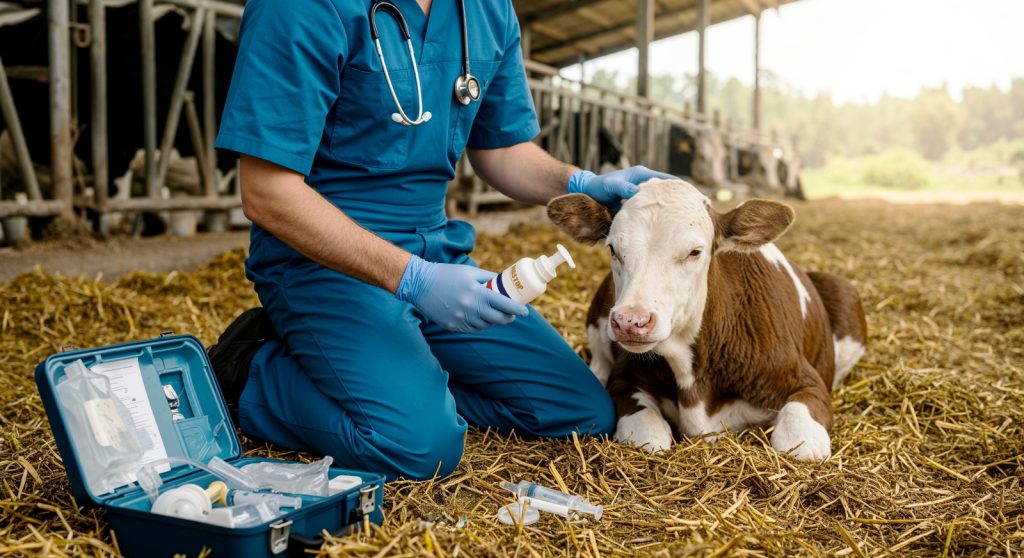
Diastop by Maizer is a manufacturer company in France of cutting-edge antidiarrheal medication designed especially to handle the complex problems associated with livestock diarrhea. Adsorbing bacterial toxins and endotoxins that prolong intestinal damage, regulating excessive gut motility without causing harmful stasis, and promoting fluid retention by enhancing intestinal tract water absorption are the three complementary ways that this novel product functions.
Diastop’s careful incorporation into treatment plans supports the animal’s natural healing processes while offering quick symptom relief. As electrolyte therapy corrects systemic imbalances, Diastop helps minimize ongoing epithelial damage by binding harmful toxins and establishing a protective intestinal environment. This two-pronged strategy, which treats both systemic dehydration and local intestinal dysfunction, demonstrates Maizer’s dedication to scientifically based veterinary solutions that improve therapeutic results.
How do I prevent diarrhea from reentering my herd?
An effective diarrhea prevention program is based on maximizing immunity and minimizing exposure of the herd to the virus. The appropriate program for each farm will vary, depending on the farm’s goals and other factors, such as open vs. closed herd, source of purchased animals, feasibility of isolation facilities, etc.
Because of the complex nature of diarrhea in neonates, it is unrealistic to expect total prevention and economical control is the major objective. The incidence of clinical disease and the case fatality rate depend on the balance between the levels of exposure to infectious agents and the resistance in the calf. Differences in herd size; availability of facilities, land, and labor; and general management objectives make it impossible to recommend specific management procedures applicable to all situations. However, several broad principles apply in all herds:
- Practice good general hygiene, in particular in maternity and calf-rearing areas
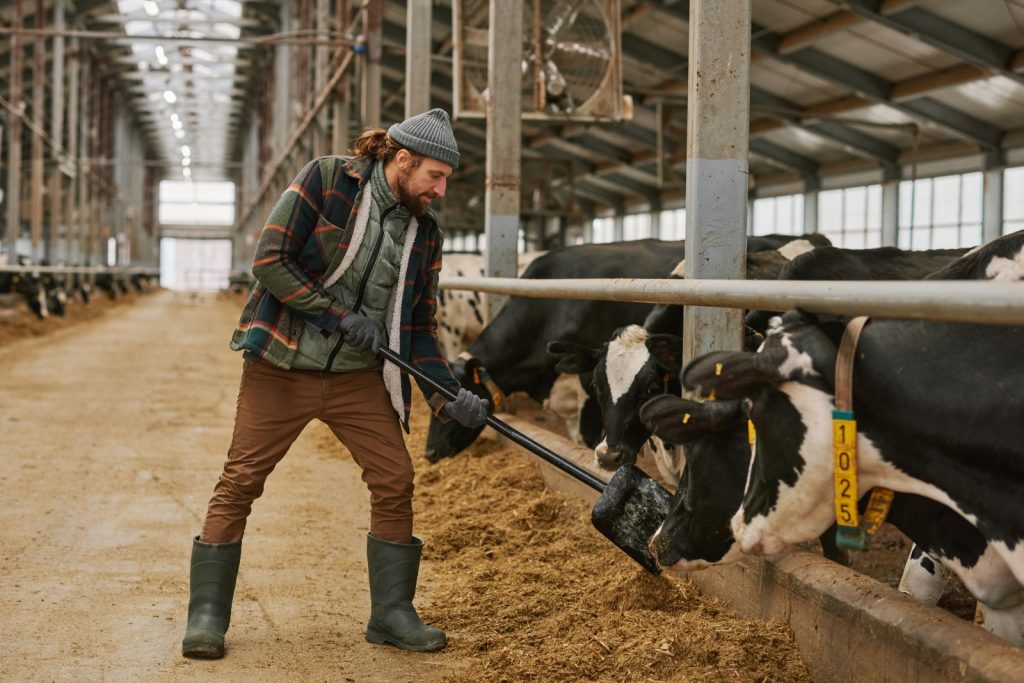
- Reduce exposure of neonates to pathogens by separating maternity pens, calf-rearing areas, and hospital pens on the premises
- Practice good colostrum management
- Avoid mingling older calves with neonates
Proper colostrum management deserves particular attention because the prevalence of failure of transfer of passive immunity in calves is still disturbingly high.
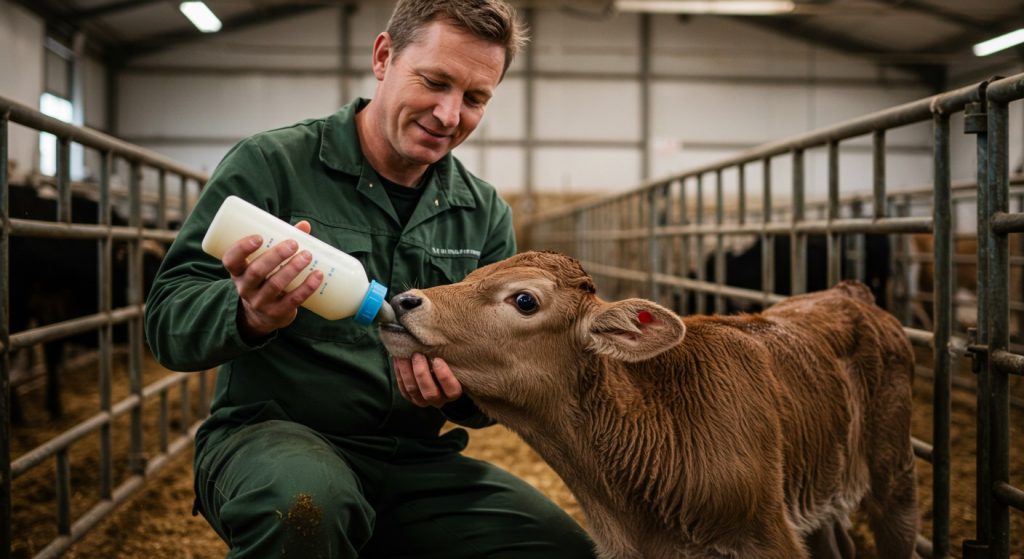
A significant portion of both naturally sucking dairy calves and calves hand fed colostrum do not acquire adequate amounts of immunoglobulin because of delayed sucking or feeding, ingestion of an inadequate volume of colostrum, or ingestion of colostrum of inferior quality. When time constraints on labor preclude an ensured intake of colostrum by nipple-bottle feeding, administration of 4 L of colostrum by esophageal feeder within the first 2 hours of life can be the best colostrum feeding policy. (Also see (Management of Reproduction: Cattle.)
Vaccination of dams late in pregnancy to boost the immunoglobulin content against rotavirus, coronavirus, or enterotoxigenic E coli in colostrum can be useful in herds in which these pathogens have been found to contribute to the neonatal diarrhea problem.

Vaccination of pregnant cows with rotavirus and coronavirus vaccines increase the amount of specific antibody in colostrum and milk, but the concentration of antibodies in milk may be insufficient to provide local antibody in the intestinal lumen during the period of peak prevalence of infection, which, in calves, is 5–15 days of age. Controlled trials of commercial vaccines have shown variable results. The addition of small amounts of immune colostrum to milk fed during the period of susceptibility can provide some protection against disease.(Merckvetmanual)



